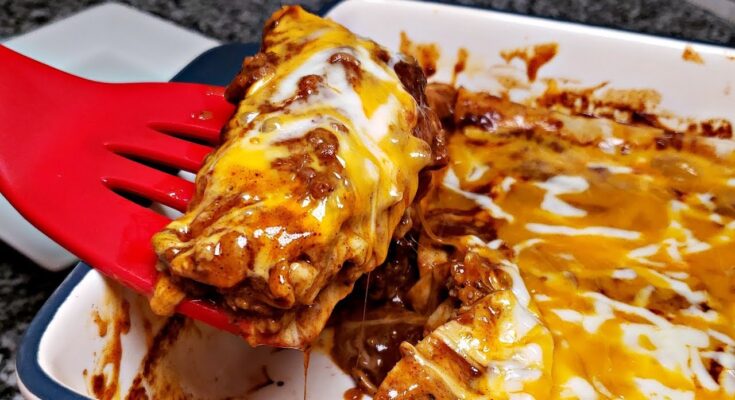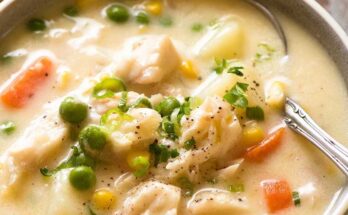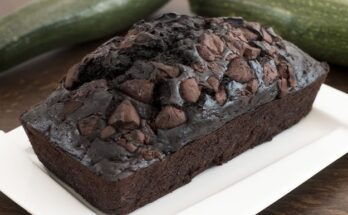Enchilada Sauce Recipe: Enchilada sauce is the heart of any good enchilada dish. Whether you’re making a classic chicken enchilada or a creative vegetarian version, this flavorful sauce ties everything together with its rich, tangy, and slightly spicy profile. While store-bought options are convenient, nothing beats the taste of a homemade enchilada sauce. It’s fresher, customizable, and free from preservatives or artificial additives. Plus, making it yourself is surprisingly simple!
In this guide, we’ll walk you through an easy recipe for enchilada sauce, breaking down each step to help you nail the perfect consistency and flavor. Once you try it, you’ll never want to go back to store-bought.
Ingredients for Enchilada Sauce
Key Ingredients
- Tomato products: Use tomato paste or tomato sauce for a rich, tangy base. Tomato paste creates a thicker sauce, while tomato sauce adds a lighter texture.
- Chili powder and spices: The soul of enchilada sauce lies in its spices. You’ll need chili powder, cumin, garlic powder, onion powder, paprika, and oregano for an authentic taste.
- Broth: Depending on your preference, use chicken, vegetable, or beef broth to create the sauce’s liquid foundation.
Optional Additions
- Fresh garlic or onions: For extra depth, finely mince and sauté garlic or onions before making the roux.
- Sweeteners: A touch of honey, sugar, or maple syrup can balance out the acidity and spiciness.
Tools and Equipment Needed
Essential Kitchen Tools
- Saucepan: A medium-sized saucepan is perfect for simmering the sauce.
- Whisk: Helps to mix ingredients evenly and avoid lumps.
- Measuring Spoons and Cups: For precise measurements of spices and liquids.
Tips for Choosing the Right Equipment
Use a non-stick saucepan to prevent burning, and ensure your whisk is sturdy enough to handle the roux without bending.
Preparing the Ingredients
Before you start, measure out all your ingredients and place them within easy reach. This will streamline the process and ensure you don’t accidentally skip a step. Keep your broth warm to make mixing easier, and pre-open all cans or spice containers.
Step-by-Step Guide to Making Enchilada Sauce
Step 1: Heating the Oil and Flour
Begin by heating 2 tablespoons of neutral oil (like vegetable or canola oil) in a saucepan over medium heat. Once the oil is warm, add 2 tablespoons of all-purpose flour and whisk continuously to create a smooth paste or roux. This step is crucial as it thickens the sauce and creates a creamy texture.
Pro Tip: Keep whisking! A burnt roux can ruin the sauce’s flavor.
Step 2: Adding Chili Powder and Spices
Add 2 tablespoons of chili powder to the roux, stirring quickly to incorporate it. Follow with the remaining spices: 1 teaspoon each of garlic powder, onion powder, cumin, and paprika, along with ½ teaspoon of oregano. This step allows the spices to bloom, intensifying their flavors.
Pro Tip: Toasting spices briefly in oil enhances their aroma and taste.
Step 3: Stirring in Tomato Products
Next, add 6 ounces of tomato paste (or 1 cup of tomato sauce) to the spiced roux. Whisk until everything is well combined. The mixture will start to thicken, forming the base of your enchilada sauce.
Pro Tip: If the mixture looks too thick, don’t worry—broth will thin it out in the next step.
Step 4: Pouring in Broth Gradually
Slowly pour in 2 cups of warm broth, a little at a time, while whisking vigorously. This prevents lumps and ensures a silky-smooth sauce. Continue whisking until the mixture reaches your desired consistency.
Pro Tip: If the sauce is too thick, add more broth, 1 tablespoon at a time. If too thin, let it simmer to reduce.
Step 5: Simmering the Sauce
Lower the heat and let the sauce simmer for 10 minutes, stirring occasionally. This allows the flavors to meld together beautifully. Taste and adjust the seasoning by adding salt, pepper, or a pinch of sugar if needed.
Pro Tip: For a smoother sauce, use an immersion blender to remove any lumps.
Common Mistakes to Avoid
- Burning the roux: Stay attentive while whisking to prevent scorching.
- Skipping the simmering step: Simmering deepens the sauce’s flavor and enhances its texture.
Adjusting the Recipe for Your Preferences
Spicing it Up or Toning it Down
One of the best things about making enchilada sauce at home is the ability to control the heat level. If you prefer a spicier sauce, add cayenne pepper or a dash of hot sauce. For a milder version, use less chili powder or incorporate a sweeter element like honey to counteract the spice.
Pro Tip: Taste as you go. Remember, you can always add more spice, but you can’t take it away.
Making it Gluten-Free or Vegan
To make the recipe gluten-free, replace the all-purpose flour with a gluten-free alternative like cornstarch or rice flour. If you’re going for a vegan-friendly version, use vegetable broth instead of chicken or beef broth. These simple swaps ensure everyone at the table can enjoy the sauce.
How to Store and Preserve Enchilada Sauce
Short-Term Refrigeration Tips
Homemade enchilada sauce can be stored in the refrigerator for up to one week. Allow the sauce to cool completely, then transfer it to an airtight container. For best results, reheat it on the stovetop, stirring occasionally to restore its smooth consistency.
Long-Term Freezing Instructions
For longer storage, freeze the sauce in portion-sized containers or freezer bags. It will keep for up to three months in the freezer. To thaw, move the container to the refrigerator overnight or place the frozen sauce directly in a saucepan over low heat.
Pro Tip: Label your containers with the date to keep track of freshness.
Creative Uses for Enchilada Sauce
While enchilada sauce is traditionally used to smother enchiladas, its versatility makes it a kitchen staple. Here are some creative ways to incorporate it into your meals:
- Topping for Burritos or Tacos: Drizzle over burritos or tacos for added flavor.
- Base for Soups or Stews: Use it as a starter for tortilla soup or chili.
- Marinade for Proteins: Coat chicken, beef, or tofu in the sauce before grilling or baking.
- Dip for Appetizers: Serve it as a dip for chips or empanadas.
Pro Tip: Experiment with different dishes to find new ways to enjoy your sauce.
Nutritional Information
Here’s a breakdown of the nutritional content for a single serving (approximately 2 tablespoons):
- Calories: 35
- Fat: 2g
- Carbohydrates: 4g
- Protein: 1g
- Sodium: 180mg
These values may vary slightly based on the specific ingredients you use, but this homemade version is generally healthier than store-bought alternatives.
FAQs about Enchilada Sauce Recipe
1. What is enchilada sauce made of?
Enchilada sauce is typically made with a blend of ingredients like tomato sauce, chili powder, garlic, onion, cumin, and broth. Some recipes include flour or cornstarch for thickening and additional spices for enhanced flavor.
2. Can I make enchilada sauce spicier?
Yes, you can adjust the spice level by adding more chili powder, cayenne pepper, or fresh chilies. Taste as you go to ensure it matches your heat preference.
3. Is enchilada sauce gluten-free?
Many enchilada sauce recipes are naturally gluten-free. However, some use flour as a thickener. To make it gluten-free, substitute with cornstarch or check the labels on store-bought options.
4. How long does homemade enchilada sauce last?
Homemade enchilada sauce can last up to a week when stored in an airtight container in the refrigerator. For longer storage, freeze it for up to three months.
5. Can I use enchilada sauce for other recipes?
Absolutely! Enchilada sauce is versatile and can be used as a base for soups, casseroles, or even as a dip for chips. Experiment to find your favorite uses.
6. What’s the difference between red and green enchilada sauce?
Red enchilada sauce is made with red chilies or chili powder, while green enchilada sauce uses green chilies and often tomatillos, giving each its unique flavor.
Conclusion
Making enchilada sauce at home is not only rewarding but also opens up endless possibilities for customizing the flavors to suit your tastes. With just a handful of pantry staples and a little effort, you’ll have a rich, flavorful sauce that enhances any dish. Plus, knowing exactly what goes into your food is always a win.
So, what are you waiting for? Grab your saucepan and whisk, and let’s make some magic in the kitchen. Your enchiladas (and your taste buds) will thank you!



